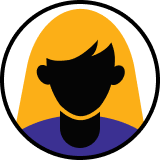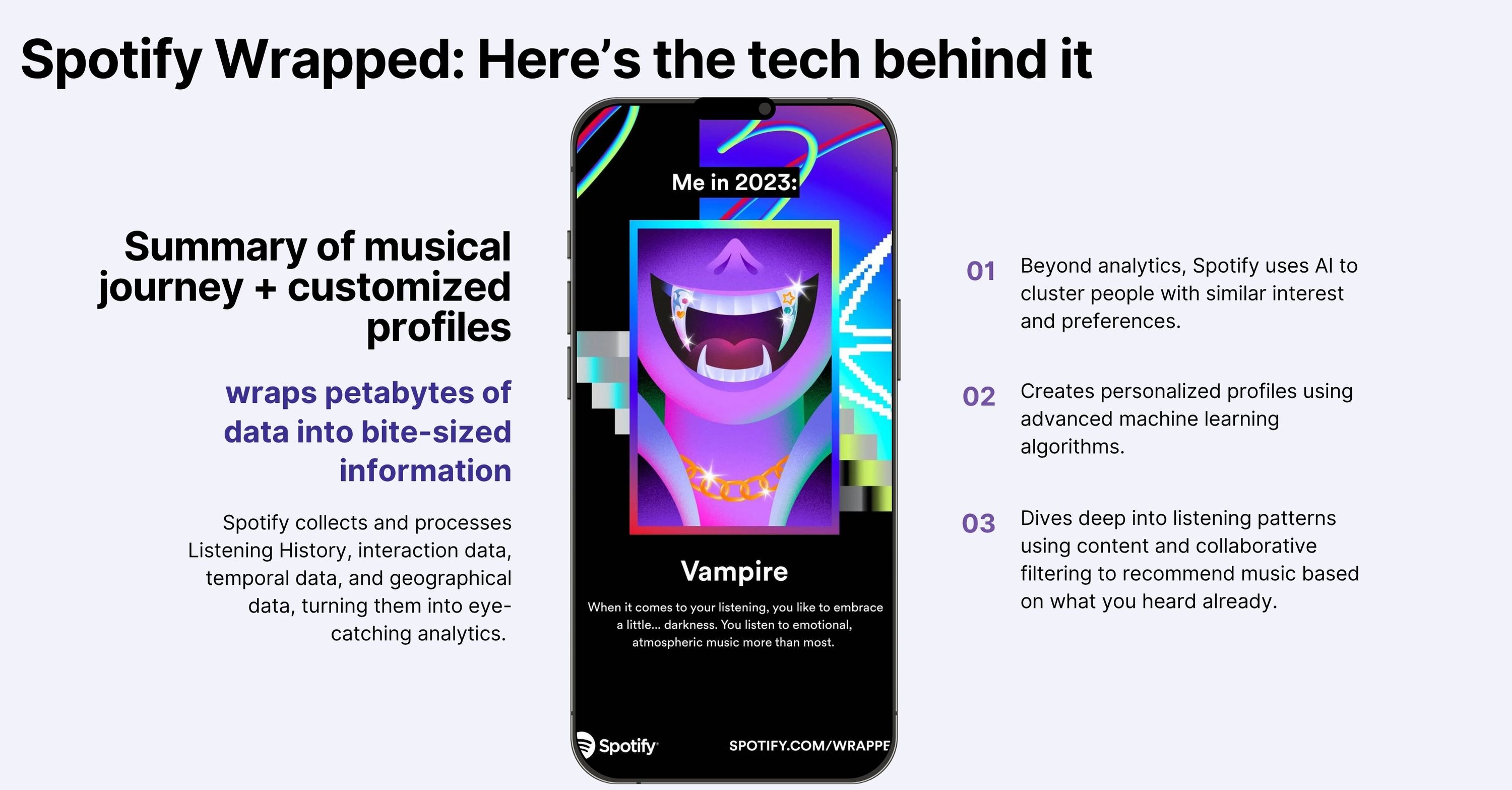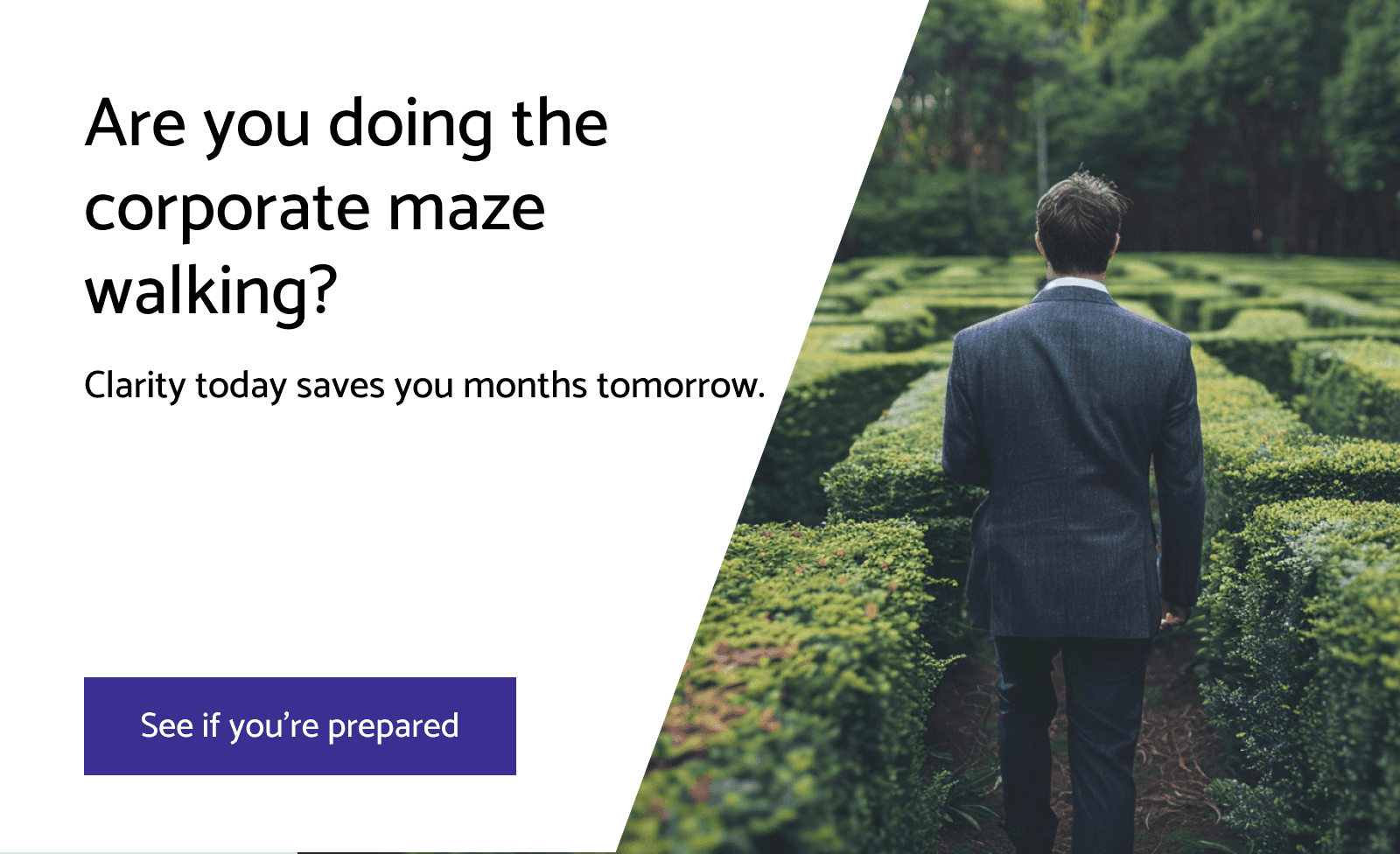How does Spotify Wrapped work?
Are you an Alchemist, Time traveler, Mastermind, or Hypnotist? That’s listening characters Spotify came up with for 2023 users. Curious about how it works - with all technical sauces? Read the blog to know how they came up with unique musical stories for every profile.

Apoorva
May 27, 2024 |
6 mins

Tune into our introduction
A nostalgic, reminiscing, and annual musical report down the year - That’s what Spotify Wrapped is all about. For those who don’t know, Spotify, the music streaming app sends customized year-end reports to users every December – a perfect example for ai use cases in media and entertainment. As there is no perfect time to back on things that shaped our year, especially our albums that entertained us, the musicians who influenced us, and the genres that kept us grooving. Looks like so much work and thought behind these cute, harmonious summaries. Have you ever wondered, though, about the magic that goes into creating this fun feature?
What is Spotify Wrapped?
Spotify Wrapped is a well-liked yearly feature wrapped with a customized overview of their listening patterns for the previous 12 months. Think of this as your personalized playlist with preferred songs and musicians—along with extra information about your preferred genres and how much time you spent listening to all of them. What’s so special about statistics on albums and songs, you might ask. It’s the crisp copy, gamified elements, personalization, and accurate representation of music choices.
All the above reasons made Spotify Wrapped the most anticipated release as its users get to assess their musical preferences and discover new artists and songs. On top of that, being able to share it on social media to flaunt their taste almost made this an addictive feature. How do they gather 615 million+ users from 180+ countries, with billions of streams? (Example: Blinding Lights by The Weekend alone has 4.2 billion impressions) - an unbelievable data analytics music industry marvel it is.

But how does Spotify Wrapped work?
Behind the scenes of how Spotify wrapped petabytes of data into bite-sized information, from the perspective of a big data consulting firm.
Data collection
It all starts with the right data. Every year, Spotify gathers a humongous amount of data about every user from January 1 to October which includes:
Listening History: All the songs, albums, artists, and genres you've listened to throughout the year are recorded.
Interaction data: All forms of app interactions, including playlist additions, skips, repeats and replays, and likes, are carefully tracked.
Temporal data: Your listening habits are also monitored based on the day of the week, time of day, and season along with the specific time or month you have listened to.
Geographical data: This is mainly to get the gist of regional trends and how that shapes your listening habits.
The foundation of Spotify Wrapped is this massive dataset and a few more, with which they create an extensive profile of your musical tastes.
Data processing and storage
Handling such massive amounts of data requires robust data processing and storage solutions. Their data processing is so strong that it leaves out unwanted details for more precise reports. For example, Spotify wrapped doesn’t include albums and artists that users listen to on a private mode, except the number of hours.
For such effective data management, Spotify uses technologies such as Apache Hadoop and Apache Kafka. When the wrapped season rolls around, these tools make sure that your listening history is processed instantly and reside safely in the cloud.
Composing insights with data analysis
Spotify Wrapped offers a profound exploration of your musical soul rather than merely summarizing your listening preferences. Data analysis comes in handy in this situation.
Descriptive Analytics
Spotify presents your favorite songs, artists, and genres in an eye-catching format with the aid of descriptive analytics. Each story shares descriptive details of the following.
How much time did you spend this year listening to music?
Which five songs would you rank highest?
Top five artists you listened to along with how much time spent on each?
New artists, songs, or any new taste that you acquired and enjoyed this year.
What genres were most popular in your playlists?
Spotify uses sequence modeling to understand and analyze temporal habits better - the type of music or artist you listen to, how long, when, and more by looking into dependencies within the data.
It presents all these rankings in the form of social media stories, something you can view, and swipe to view the next.
Cluster analysis: Finding your musical peers
Wrapped isn’t just an exclusive report. It goes beyond to make you feel inclusive by grouping you with users of similar interests and listening habits and clustering you under one of their musical personalities. Think of this like a Myers-Brigs test but for music. Whether you're a pop enthusiast, a classical aficionado, or a Metalhead, Spotify uses cluster analysis to understand and categorize your musical preferences, making your Wrapped experience uniquely personal. It uses k-means clustering to split users based on genres and artists they listen to. Example: Segmenting users who listen to rock music more. And it uses hierarchical clustering to understand the hierarchy and nested structure of the music you listened to. Like genre - artist - album.
Look at one of their clustering that clubbed users who listened to jazz songs alone at midnight (considering the global timing zones).
Art of personalization
Essentially, Spotify Wrapped is all about personalization. Spotify guarantees personalization for every Wrapped experience by utilizing advanced machine learning algorithms.
Collaborative filtering for accurate recommendations
Based on the listening preferences of users with similar tastes, collaborative filtering makes music recommendations. Spotify uses techniques like matrix factorization, which is typically used in recommendation systems to derive user-item interaction matrices and uncover underlying listening patterns.
That’s why you'll probably see a new band in your recommendations if other fans of indie rock have been enjoying it as much as you have.
K-Nearest neighbors are also applied to find out users with similar listening patterns and unwrap their trends and tendencies to share useful musical insights and recommendations to you.
Content-based filtering
Song recommendations based on content-based filtering show you songs that share qualities with your previous favorites. This guarantees that if you enjoyed a lively pop song, you could find more that share a similar tempo and feel.
Hybrid models - best of both worlds
Spotify employs hybrid models that blend content-based and collaborative filtering to provide more precise and tailored recommendations. This guarantees an accurate representation of your musical journey.
Visualizations
Spotify Wrapped’s eye-catching visual presentation makes it all the more captivating. Complex data and stats are transformed into readable, visually appealing stories through data visualization.
A walk down memory lane with interactive stories
Your year in music is guided by interactive stories that provide you with important data and highlights logically and entertainingly.
A picture-perfect summary
Stunning infographics that are simple to share on social media highlight your listening trends, including your favorite genres, most-played songs, and listening duration.
Natural Language Processing - words that resonate
They use NLP to produce suitable, catchy text for each slide. The right message elevates the whole Wrapped experience and makes it more relatable and pleasurable with personalized messages, summaries of listening habits, and popular phrases.
Predicting the future with analytics
Spotify can forecast user behavior based on historical data, thanks to predictive analytics. Spotify can anticipate user needs, enhance user retention strategies, and improve algorithms by comprehending trends and patterns.
The Encore: User feedback loop
The end of the Wrapped slides helps users share feedback. With the feedback obtained, Spotify improves the Wrapped experience to improve the service year after year and improve its algorithms.
Business benefits
Spotify Wrapped is not just a fun feature; it’s a powerful tool for business growth. It’s a way they honor artists who have been entertaining users for the whole year with a digital wall of fame.
User engagement: Wrapped creates a buzz, increasing user engagement.
Customer retention: Personalized interactions increase user loyalty and satisfaction.
Brand promotion: By drawing in new users, social sharing serves as free advertising.
Data-Driven Insights: Understanding customer preferences, influences marketing tactics and business choices.
Conclusion
Spotify Wrapped is a prime example of how data science can be used to create individualized, interesting, and delightful user experiences. It’s also a great example of data-driven storytelling and how boring data could be transformed into likable presentations with the best data visualization techniques.
So many ML and AI techniques like NLP, anomaly detection, sequence modeling, clustering, filtering, and user-friendly design go behind to convert your musical journey into a narrative that is worth telling and sharing. It proves how data analysis and pattern recognition could be done accurately at a large scale. Thus, keep in mind the data science symphony that is being played in the background the next time you open your musical year.
Turn raw data into powerful insights—discover our data science and analytics services.

by Apoorva
Apoorva, ex data scientist at datakulture, worked closely with the data science team—supporting research, data exploration, training, and model-building activities. With a strong blend of analytical, creative, and communication skills, she loved spreading knowledge through engaging audiences in events, writing blogs and technical papers, and participation in platforms like Medium.



